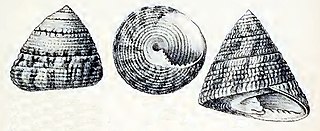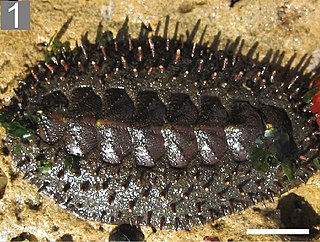
Chitons are marine molluscs of varying size in the class Polyplacophora, formerly known as Amphineura. About 940 extant and 430 fossil species are recognized.

The gumboot chiton, also known as the giant western fiery chiton or giant Pacific chiton, is the largest of the chitons, growing to 36 cm (14 in) and capable of reaching a weight of more than 2 kg (4.4 lb). It is found along the shores of the northern Pacific Ocean from Central California to Alaska, across the Aleutian Islands to the Kamchatka Peninsula and south to Japan. It inhabits the lower intertidal and subtidal zones of rocky coastlines. The gumboot chiton's appearance has led some tidepoolers to refer to it, fondly, as the "wandering meatloaf". The name "gumboot chiton" seems to derive from a resemblance to part of a rubber Wellington boot or "gum rubber" boot.

Henry Augustus Pilsbry was an American biologist, malacologist and carcinologist, among other areas of study. He was a dominant presence in many fields of invertebrate taxonomy for the better part of a century. For much of his career, his authority with respect to the classification of certain substantial groups of organisms was unchallenged: barnacles, chitons, North American terrestrial mollusks, and others.

Coelotrochus oppressus, common name the shouldered top shell, is a species of very small sea snail, a marine gastropod mollusc in the family Trochidae, the top snails or top shells.

Chiton is a genus of chitons, a polyplacophoran mollusk in the family Chitonidae.

Mopalia spectabilis, commonly known as the red-flecked mopalia, is a species of chiton.

Tonicella is a genus of chitons known as the lined chitons.

Chiton magnificus, the liquorice sea cradle, is a Southeast Pacific species of edible chiton, a marine polyplacophoran mollusk in the family Chitonidae, the typical chitons.

Chitonidae is a family of chitons or polyplacophorans, marine mollusks whose shell is composed of eight articulating plates or valves. There are fifteen extant genera in three subfamilies.

Acanthopleura is a genus of chitons in the family Chitonidae. In this genus the girdle is spiny or spiky. It has eight described species at present.

Acanthopleura granulata, common name the West Indian fuzzy chiton, is a medium-sized tropical species of chiton. This type of chiton's activity does not depend on spring-neap oscillations leading to lower locomotion loss. Its morphology is different from usual chitons as it has a fifth valve, which is split into halves.

Chitonida is an order of chitons. The order was erected to class chitons with elaborate hull outgrowths on their eggs.

Acanthochitonidae is a family of marine mollusks belonging to the class Polyplacophora, commonly known as chitons. Species are widely distributed throughout the world's oceans, but are most commonly found in the shallow waters of the Pacific Ocean, from Alaska to Chile.

Chaetopleura is a genus of chitons in the family Chaetopleuridae. The species within this genus are marine molluscs.
Nuttallochiton is a genus of chitons; the only one to have paired rather than fused gonads.

Calliotrochus marmoreus is a species of sea snail, a marine gastropod mollusk in the family Trochidae, the top snails.

Trochus stellatus, common name the stellate trochus, is a species of sea snail, a marine gastropod mollusk in the family Trochidae, the top snails. The species is now extinct.

Enoplochiton echinatus is a Southeast Pacific species of edible chiton, a marine polyplacophoran mollusc in the family Chitonidae, the typical chitons.
Acanthopleuribacter pedis is a Gram-negative, rod-shaped bacterium found in marine environments.
Archimediella is a genus of sea snails, marine gastropod mollusks in the family Turritellidae.
















